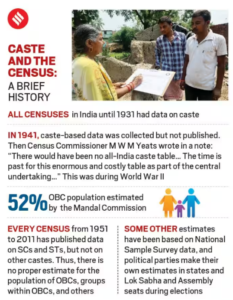Context: Supreme Court will hear petitions challenging the Patna High Court’s verdict upholding the Bihar government’s ongoing caste survey.
About Caste Survey in Bihar:


- Aim: To collect demographic data like the number of households, the number of people in each household, their socio-economic conditions, and their castes.
- It is a survey, not a census, as the Indian Constitution does not empower state governments to conduct census-gathering exercises.
- The decennial Census of India measures demographic data like age, marital status, religion, whether Scheduled Caste/Scheduled Tribe, mother tongue, education level, disability, economic activity, migration, and fertility.
- Thus, there is readily available data on the number of individuals belonging to SCs or STs and to different religious groups.
- However, since 1931, no census in India has measured the number of OBCs in the country.
- Mandal Commission made its recommendation for bringing 27 percent reservation for OBCs based on the data of the census of 1931.
- The commission used extrapolated data and determined that 52 percent of the total population of India, outside of ST and SC, belonged to OBCs.
- While the Socio-Economic and Caste Census (SECC) was conducted in 2011, its result was never published by the central government.
- It is conducted through a comprehensive program involving the Ministry of Rural Development, Ministry of Housing and Urban Poverty Alleviation, The Office of the Registrar General and Census Commissioner, India and the State Governments.
- Aim: Collecting data on the socio-economic and caste status of households and individuals living in rural areas of India.
- Significance: Tool for the government to identify and target social welfare schemes and programs to those who are most in need.
- Indicators used to determine socio-economic status in the census:
- Ownership of assets such as land, house, and vehicle
- Type of house (pucca, semi-pucca, or kaccha)
- Access to basic amenities such as electricity, water, and sanitation
- Occupation and education level of household members
- Income levels of household members
Post Views: 708
